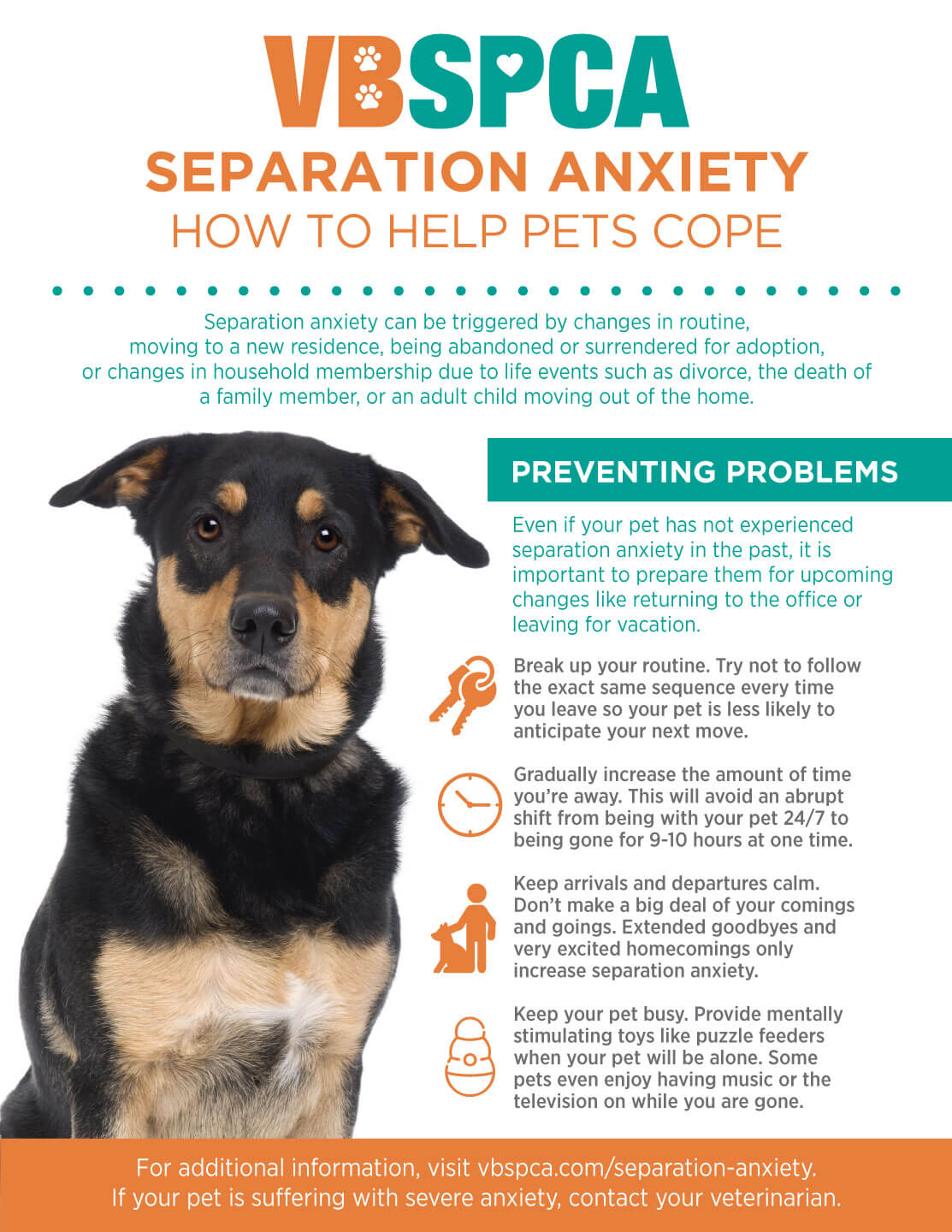While the COVID-19 pandemic brought a multitude of challenges for humans, many pets benefitted from the changes to all of our lives. With the rise of teleworking, virtual learning, and a lack of social engagements and travel plans, animals had more time than ever with their pet parents.
Many people have returned to the office and started socializing more often. However, our return to “normalcy” can be hard for many dogs and cats who may experience separation anxiety. But with some planning and training, you can help your pets cope with these changes.
What is Separation Anxiety?
Separation anxiety is when an animal becomes stressed or upset when not in the presence of his pet parent(s). While this condition is more often associated with dogs, cats can also experience separation anxiety. The signs of separation anxiety can range from mild to severe and even dangerous. Signs of separation anxiety include:
- Going to the bathroom in the house/outside the litterbox
- Barking, howling, meowing, or crying
- Chewing, digging, destroying things
- Pacing
- Excessive grooming
- Attempting to escape home or area in which the pet is confined by chewing or digging at doors/windows
Separation anxiety can be triggered by changes in routine, moving to a new residence, being abandoned or surrendered for adoption, or changes in household membership due to life events such as divorce, the death of a family member, or an adult child moving out of the home.
Preventing Problems
Even if your pet has not experienced separation anxiety in the past, it is important to prepare them for upcoming changes like returning to the office or leaving for vacation. Here are a few ideas to prevent stress in your pets:
- Break up your routine. Most people are creatures of habit. Pay close attention to what you normally do before you leave the house and try not to follow the exact same sequence every time. For example, you usually pack your lunch, put on your socks and shoes, and then gather your purse/wallet/coat right before walking out the door. Try doing those things in a different order, or taking breaks in between each action so your pet is less likely to anticipate your next move. You can also do things like picking up your keys on your day off and going to the door but not actually leaving. Your pet will learn that keys don’t always mean they’re about to be alone.
- Gradually increase the amount of time you’re away. If possible, start leaving your pet for short periods of time now. Run an errand or take a walk around the block without your pet so he can get used to you not being with him. This will avoid an abrupt shift from being with your pet 24/7 to being gone for 9-10 hours at one time.
- Keep arrivals and departures calm. While there is nothing like a happy welcome from your pet after a long day, don’t make a big deal of your comings and goings. Extended goodbyes and very excited homecomings only increase separation anxiety.
- Keep your pet busy. Providing things for your pet to do both when you are home and when you are gone is very important. Go for walks and play with your pet to help him get some of his energy out when you are together. Provide mentally stimulating toys like puzzle feeders when your pet will be alone. Some pets even enjoy having music or the television on while you are gone.
Seek Solutions
Some pets may still experience separation anxiety despite your best efforts. While some of their behaviors due to their anxiety may frustrate you, it is important to seek solutions instead of punishing them. Consult with your veterinarian if you feel you need help. There are medications and supplements that can help severe cases of separation anxiety. You can also reach out to a qualified trainer who can provide expert advice specific to your pet.
Remember, your pet loves you and is happiest when he can spend time with you. By setting him up for success and helping him to realize you will always return home, you can help your pet become confident and happy even when you are not around.
Need more information? Click here for additional information on separation anxiety from the ASPCA.





Last Updated: June 2, 2022 by vbspcaadmin
Separation Anxiety | How To Help Pets Cope
While the COVID-19 pandemic brought a multitude of challenges for humans, many pets benefitted from the changes to all of our lives. With the rise of teleworking, virtual learning, and a lack of social engagements and travel plans, animals had more time than ever with their pet parents.
Many people have returned to the office and started socializing more often. However, our return to “normalcy” can be hard for many dogs and cats who may experience separation anxiety. But with some planning and training, you can help your pets cope with these changes.
What is Separation Anxiety?
Separation anxiety is when an animal becomes stressed or upset when not in the presence of his pet parent(s). While this condition is more often associated with dogs, cats can also experience separation anxiety. The signs of separation anxiety can range from mild to severe and even dangerous. Signs of separation anxiety include:
Separation anxiety can be triggered by changes in routine, moving to a new residence, being abandoned or surrendered for adoption, or changes in household membership due to life events such as divorce, the death of a family member, or an adult child moving out of the home.
Preventing Problems
Even if your pet has not experienced separation anxiety in the past, it is important to prepare them for upcoming changes like returning to the office or leaving for vacation. Here are a few ideas to prevent stress in your pets:
Seek Solutions
Some pets may still experience separation anxiety despite your best efforts. While some of their behaviors due to their anxiety may frustrate you, it is important to seek solutions instead of punishing them. Consult with your veterinarian if you feel you need help. There are medications and supplements that can help severe cases of separation anxiety. You can also reach out to a qualified trainer who can provide expert advice specific to your pet.
Remember, your pet loves you and is happiest when he can spend time with you. By setting him up for success and helping him to realize you will always return home, you can help your pet become confident and happy even when you are not around.
Need more information? Click here for additional information on separation anxiety from the ASPCA.
Category: VBSPCA News
Search
Ways to Give
Annual Sponsors
To view our Donor Privacy Policy, click here.